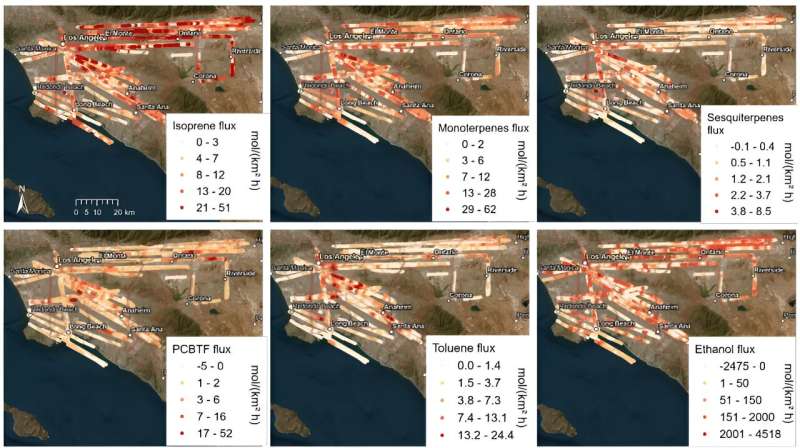This article has been reviewed according to Science X's editorial process and policies. Editors have highlighted the following attributes while ensuring the content's credibility:
fact-checked
peer-reviewed publication
trusted source
proofread
Study shows rising temperatures affect air quality over Los Angeles

Particulate matter and ozone are a major problem for people and the environment. Dr. Eva Pfannerstill, young investigator group leader at Jülich's Institute of Energy and Climate Research (IEK 8), is investigating where the volatile organic compounds (VOCs) responsible for particulate matter and ozone come from and what climate change has to do with it.
In her paper, which was written at the University of California, Berkeley, and recently published in Science, she sheds light on the contribution of plant and human emissions to the air quality of Los Angeles.
Catalytic converters and filter systems as well as the switch to electromobility have significantly reduced the pollution caused by vehicles emissions and industrial waste gases in recent decades. "However, air quality in megacities like Los Angeles has not improved to the same extent. It has been stagnating since about 2010," says Pfannerstill.
"What other sources of volatile organic compounds are there that we may have underestimated?" she asks. The key to this answer lies in the complex interaction between nitrogen oxides from combustion processes of fossil fuels, rising temperatures, and the resulting increase in emissions from plants as well as the increasing emission rates of petrol, paints, varnishes, or artificial fragrances.
Plants under stress
Heat, drought, and pests trigger stress reactions in plants. Such reactions alter the amount and composition of the gaseous substances that the plants release into the air. These include volatile organic compounds (VOCs), terpenoids such as isoprene or monoterpenes, and sesquiterpenes.
The composition of the released molecules changes depending on the type of stress. How exactly this mix of molecules varies is the subject of intensive research, including with respect to climate change. At the same time, some of the biogenic substances react with nitrogen oxides from vehicle emissions or other emissions to form ozone and also contribute to the formation of aerosols—which can have a cooling effect on the climate—as well as harmful particulate matter.
Localize sources
Pfannerstill and her colleagues used state-of-the-art instruments and a special calculation method during several measurement flights over Los Angeles. This combination provided an unprecedented wealth of measurement data on more than 400 different volatile organic compounds and their sources. In addition to the typical plant-based substances, these included vehicle emissions, solvents, and even cleaning and personal care products.
"The special thing about our method is that we are able to record 10 measurement points per second for the concentration of these substances and simultaneously analyze the wind in three dimensions with the same measurement frequency. This allows us to quantify exactly which quantities of the measured substances are actually emitted in the city and have not been transported there from somewhere else," says Pfannerstill.
Reduction of nitrogen oxides necessary
The results showed a clear correlation between daytime temperature and exposure to particulate matter and ozone. At 20°C, this was low in both cases, but at more than 30°C the pollutants increased very sharply. The measurements also showed that terpenoids from plants are the main drivers of what occurs at high temperatures, followed by emissions from solvents. Both then react with the nitrogen oxides from exhaust gases to form ozone and particulate matter.
"Analyses show that the current nitrogen oxide emissions in Los Angeles would have to be reduced by a further 50% in order to minimize ozone pollution at high temperatures," reports Pfannerstill.
At the same time, Pfannerstill points to a special feature of the Los Angeles cityscape: "Eucalyptus trees make up around 5 % of the local tree population. These trees emit a lot of monoterpenes.
"The flowering of jacaranda trees, one of the most common tree species in Los Angeles, may also have contributed to the high monoterpene and sesquiterpene concentrations that we measured during the flights. Drought stress also increases the emissions of both terpene species," she adds.
Flights planned over German forests
Eva Pfannerstill joined Jülich's climate research team in January 2024 and will soon be using her newly developed analytical methods to measure the skies over Germany, specifically the substances that are released into the air from cities and forests. Together with several working groups, two large zeppelin measurement campaigns are planned. Here too, the aim is to understand the connection between climate change, stressed plants, and man-made emissions.
"We will start next year with a test flight during which we will check the instruments and their suitability for flight. The two major measurement campaigns will then start in 2026 and 2028," adds Pfannerstill.
The data are an important addition to climate models, since previous calculations on the stress response of forests are often based on laboratory measurements with a small number of small trees (Jülich's SAPHIR atmospheric chamber also carries out such measurements). The researchers will then compare the results from these laboratory tests with the data from the measurement flights and refine existing models.
"That's what makes Jülich research so special. We can collect data from the real world with the help of large-scale measurement campaigns and reproduce these on a smaller scale in the lab in a controlled manner. Modelers use the collected data in calculations and models to scale the correlations to a larger scale.
"Ultimately, the results serve to demonstrate ways in which air quality can be improved in a changing Earth system," explains Pfannerstill.
More information: Eva Y. Pfannerstill et al, Temperature-dependent emissions dominate aerosol and ozone formation in Los Angeles, Science (2024). DOI: 10.1126/science.adg8204
Journal information: Science
Provided by Forschungszentrum Juelich





















